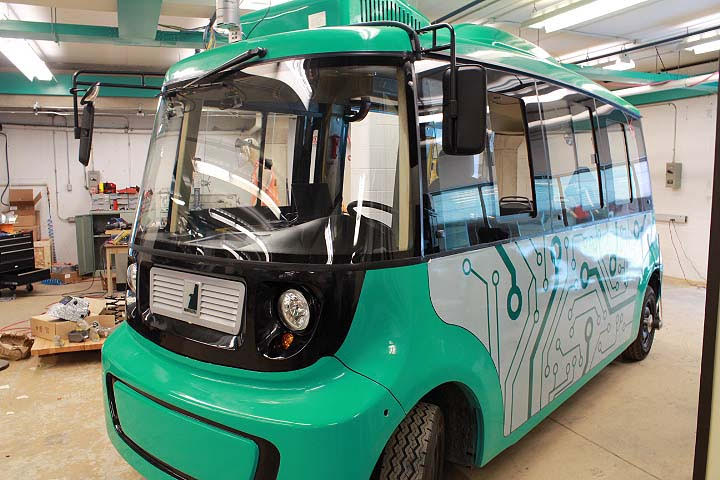You may have seen a small teal bus driving around campus, carrying students and a laptop. This is the “All-weather Waterloo Autonomous Shuttle Bus,” the latest project from the team the Mechatronic Vehicle System (MVS) lab. Amir Khajepour, a professor of Mechanical and Mechatronics Engineering at UW, has stated that the project is not sponsored or supported by any company.
This is the second Autonomous Vehicle (AV) to be created at UW, the first being the Autonomoose.
The Autonomoose was not only UW’s first AV, but also Canada’s first AV to drive on public roads. The Autonomoose is a Lincoln MKZ Hybrid outfitted with multiple sensors and components with an autonomous drive-by-wire (DBW) operation; DBW means the car uses a computer to operate the a its functions. It is similiar to pressing a button to roll up window instead of rolling it up manually. It took multiple cross-disciplinary skills such as electrical engineering and software engineering to create the Autonomoose. It was a major endeavor to get the Autonomoose on the road that required combining various components and skills together. the autonobus is now UW’s second AV and is underway thanks to MVS.
The MVS team consists of Khajepour, his graduate students, postgraduates, technicians, and some times, co-op students. According to Khajepour, the bus the team is working on is manufactured by Suzhou Lexsong Electromechanical Equipment Co. Ltd, a Chinese company. Jeff Graansma and Aaron Sherratt, the research laboratory technicians at MVS, clarified that the team was unable to find a suitable bus with an electric engine locally. They explained that, aside from the bus being a greener alternative, an electric engine is more convenient for maintenance and quieter than an internal combustion engine when operating. For these reasons, the team decided to opt for the slow-moving bus designed for tours.
The goal for the project is to craft an all-weather autonomous bus that can be sent to any location within three days and replicate the functions of a regular bus. When asked how the AV will be able to navigate, Khajepour explained that the AV has multiple sensors and can use external cameras, such as the ones from the buildings, to help the AV avoid collisions. Both Khajepour and the laboratory technicians have stated that they use open-source software and algorithms modified in-house for the project specifically. According to Sheratt, the combined use of the sensors are able to detect an object and estimate its distance in relation to the sensors. Though, this does beg the question, can the AV be hacked?
“That is an issue in any connected system including autonomous vehicles. Although connectivity in autonomous systems is not as critical as many other systems,” Khakepour said.
This AV is not designed for connectivity. Sheratt clarified that the AV uses an enclosed system design, similar to airliners that have an auto-pilot feature. In order for a hacker to be able to tamper with the software or algorithm, the hacker would need to physically be in the AV with access to the computer running the sensors in order to do anything.
Without a doubt, this AV is another arduous undertaking. Both Sherrat and Graansma stated that they directed and supervised the students, ensured protocol is followed, and tested student-created algorithms. Both technicians enjoy working on the project as well as similar ones, like the Autonomoose, and reported that students are just as enthusiastic to work on the project as they are. The bus is still in the development and testing phase, but the team is hard at work to meet their goals. At the time of publication, UW will have hosted the grand opening of new Autonomous Vehicle Research and Intelligence Lab with the Honourable Navdeep Bains, the Minister of Innovation, Science, and Industry, present for the opening on Feb. 11, 2020.

































